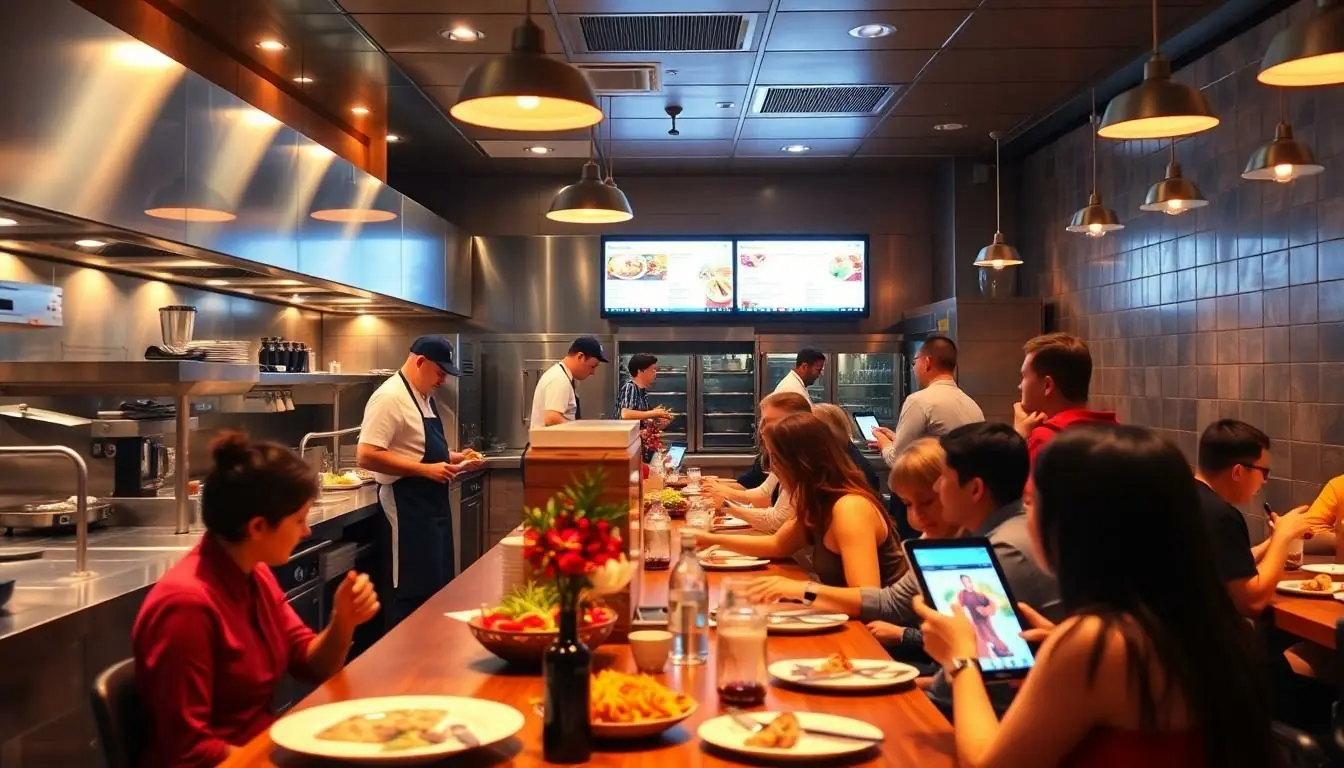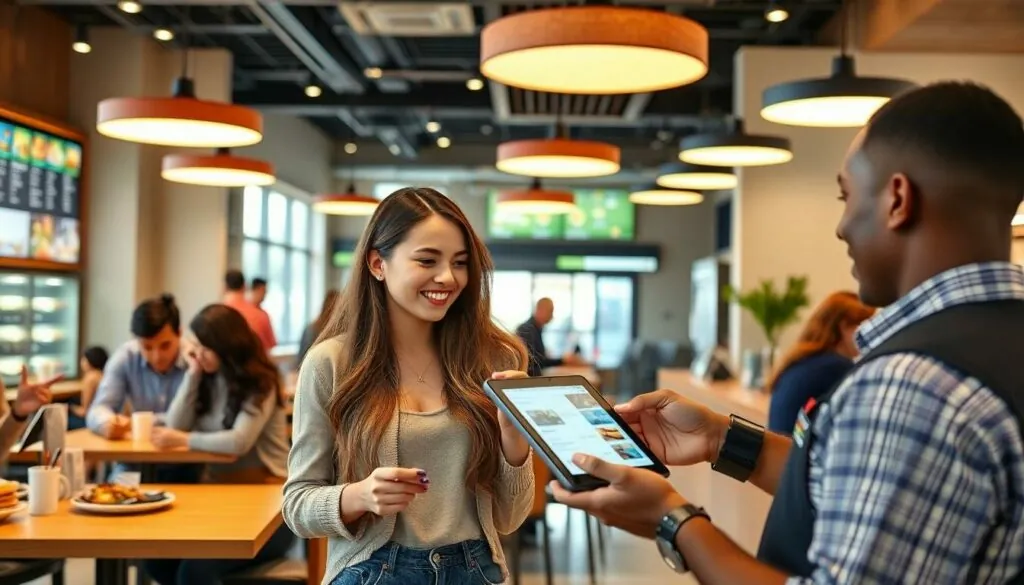In a world where people can order food with a tap and a swipe, restaurants are stepping up their game like never before. Gone are the days of scribbled orders and paper menus; technology is now the secret ingredient that’s transforming the dining experience. From AI-powered chatbots to contactless payments, the latest trends are not just changing how meals are served but also how customers interact with their favorite eateries.
Table of Contents
ToggleOverview of Technology in Restaurants Trends
Technology plays a vital role in the transformation of restaurants, reshaping how dining experiences are designed and delivered. AI-powered chatbots enhance customer service by providing instant support, while online reservations streamline table management. Many establishments now utilize digital menus, making it easier for patrons to browse offerings and place orders.
Contactless payments have gained traction, promoting a hygienic dining environment and quick transactions. Restaurants increasingly adopt mobile apps for loyalty programs, engaging customers and encouraging repeat visits. Data analytics tools assist in understanding consumer preferences, allowing for tailored marketing strategies and improved menu selection.
Robotic kitchen assistants are becoming common, preparing dishes with precision and efficiency. These innovations reduce labor costs and maintain consistency in food quality. Similarly, augmented reality offers immersive experiences, allowing customers to visualize dishes before ordering.
Social media integration also plays a crucial role, enabling restaurants to connect with their audience through engaging content and promotions. Virtual kitchen concepts, or ghost kitchens, continue to rise, focusing on delivery without traditional dining spaces.
Customer feedback is now gathered through online platforms, enabling prompt adjustments to enhance satisfaction. Advanced inventory management systems help reduce waste by analyzing consumption patterns more effectively.
Innovations in delivery logistics, including drone and robot deliveries, are on the horizon, promising faster service. Overall, these trends illustrate how technology in restaurants enhances efficiency, improves customer experience, and responds to evolving market demands.
Impact of Technology on Restaurant Operations

Technology significantly reshapes restaurant operations, leading to increased efficiency and improved customer satisfaction.
Streamlining Processes with Automation
Automation simplifies various tasks in restaurants. Order processing requires minimal human intervention, enhancing speed and accuracy. Staff schedules optimize labor costs through smart scheduling software. Inventory management systems track supplies in real-time, reducing waste and preventing shortages. Automated kitchen equipment ensures consistent food quality, allowing chefs to focus on creativity. Reservation systems manage bookings smoothly, minimizing no-shows and maximizing table turnover. Overall, automation facilitates a seamless workflow, allowing restaurants to operate more efficiently.
Enhancing Customer Experience with Technology
Technology elevates the customer experience in several ways. Digital menus enable diners to browse options conveniently, often featuring photos and detailed descriptions. Online ordering systems save time, allowing customers to place orders from anywhere. Personalization plays a critical role, with various platforms recommending dishes based on previous orders. Contactless payment methods cater to hygiene-conscious patrons, providing a safe transaction experience. Additionally, customer feedback tools allow for immediate response, helping restaurants adapt quickly to consumer preferences. These technological advancements create a more enjoyable and engaging dining atmosphere.
Key Technologies Transforming Restaurants
Technology continues to revolutionize the restaurant industry, enhancing operations and customer experiences. Several key technologies stand out in this transformation.
Mobile Ordering and Payments
Mobile ordering systems streamline the ordering process for diners and restaurants. Customers can browse menus, customize orders, and pay seamlessly through their smartphones. Research shows that mobile orders can increase ticket sizes by 20 to 30 percent. Efficiency improves since patrons avoid long wait times. Payment options include various digital wallets and contactless solutions, boosting convenience for users and promoting hygiene.
Online Reservations and Waitlist Management
Online reservation systems simplify the booking process for guests. Customers can secure table reservations effortlessly, often receiving instant confirmations. Approximately 70 percent of diners prefer online reservations over traditional methods. Waitlist management tools provide a clear overview of seating availability, allowing restaurants to optimize guest flow. Automation in this area reduces no-shows and enhances customer satisfaction by offering precise wait time estimates.
Contactless Dining Solutions
Contactless dining solutions prioritize safety and convenience in a post-pandemic world. Digital menus, accessed via QR codes, eliminate the need for physical menus and reduce touchpoints. More than 60 percent of diners appreciate contactless options for their hygiene benefits. Additionally, contactless payments further streamline the checkout process. These innovations not only enhance the dining experience but also foster customer trust in restaurant operations.
Future Trends in Restaurant Technology
Technology continues transforming the restaurant landscape, influencing customer experiences and operational efficiency. Emerging trends focus on further integration of advanced tools and systems, particularly in artificial intelligence, data analytics, and immersive technologies.
Artificial Intelligence and Data Analytics
AI enhances customer service by providing tailored recommendations based on data. Analytics tools track consumer preferences, allowing restaurants to adjust their offerings accordingly. Insights derived from customer data improve marketing strategies, increasing the effectiveness of promotions. Restaurants leveraging these technologies can boost sales by up to 30 percent due to increased order accuracy and personalized experiences. Predictive analytics also aid in anticipating trends, enabling proactive adjustments to menus and staffing levels. By adopting AI-driven solutions, restaurants optimize operations and enhance engagement, cultivating customer loyalty.
Virtual and Augmented Reality Applications
Virtual and augmented reality redefine dining experiences and marketing efforts. These technologies offer immersive environments that enable customers to explore menu items visually before ordering. Restaurants utilizing AR can increase customer engagement through interactive elements, leading to higher ticket sizes. For instance, diners can visualize dish components or witness the preparation process. Incorporating VR in marketing campaigns enhances outreach, allowing potential customers to experience the ambiance digitally. Implementing these technologies can lead to greater customer satisfaction and enhanced loyalty, positioning restaurants as innovators in the competitive market.
Challenges and Considerations
Implementing technology in restaurants presents several challenges that operators must navigate. Investment costs for new systems often pose a significant barrier, especially for small businesses. Training staff on new tools and software can be resource-intensive, requiring time and effort to ensure efficiency. Additionally, some diners may resist adopting contactless solutions or digital menus, favoring traditional interactions.
Data security stands as a prominent concern. Protecting customer information against breaches is crucial, and restaurants must implement robust cybersecurity measures. Integrating technology into existing systems can also lead to compatibility issues, causing disruptions if not managed well. Staffing challenges may arise as automation replaces certain roles, leading to potential pushback from employees.
Operational workflow can experience disruption during the transition to highly automated systems. Restaurants must find a balance between automation and personal service to maintain a welcoming atmosphere. Reliability of technology plays a vital role; system outages can impede operations, affecting customer experience and revenue.
As restaurants embrace technology, they must remain vigilant in maintaining a personal touch. Striking this balance can determine customer loyalty in a rapidly evolving market. Feedback mechanisms must be in place to assess how technology impacts customer satisfaction and operational efficiency. Regular evaluations of tech effectiveness will help in addressing issues quickly and ensuring alignment with evolving consumer preferences.
Lastly, restaurants must keep an eye on emerging trends. Keeping up with rapid advancements in technology ensures they stay competitive. Understanding customer expectations supports the continual adaptation of technology solutions, reinforcing trends in online ordering and contactless payments. Addressing these challenges effectively maximizes the benefits of technology in enhancing dining experiences.
The integration of technology in restaurants is reshaping the dining landscape. As establishments adopt innovative solutions they not only enhance operational efficiency but also elevate the customer experience. From AI-driven chatbots to contactless payments these advancements cater to modern consumer expectations and preferences.
While challenges remain such as investment costs and staff training the benefits of embracing technology are undeniable. Restaurants that stay ahead of trends will likely thrive in a competitive market. By balancing automation with personal service they can foster loyalty and satisfaction among diners. The future of dining is bright as technology continues to evolve and transform the way people enjoy their meals.





